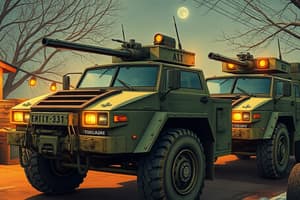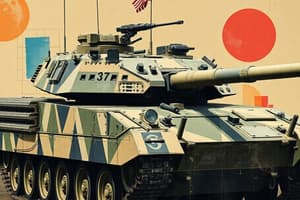Podcast
Questions and Answers
Which type of vehicle is typically used for logistics in the military?
Which type of vehicle is typically used for logistics in the military?
- Humvee
- Ambulances
- MRAPs
- Logistics vehicles (correct)
Defensive driving techniques are focused on anticipating and reacting to potential hazards.
Defensive driving techniques are focused on anticipating and reacting to potential hazards.
True (A)
What is one purpose of the drivers training in the military?
What is one purpose of the drivers training in the military?
To ensure readiness for operations in diverse environments.
The _____ vehicles are used for transporting troops and equipment safely in combat situations.
The _____ vehicles are used for transporting troops and equipment safely in combat situations.
Match the following training components with their descriptions:
Match the following training components with their descriptions:
What is a requirement for completing drivers training in the military?
What is a requirement for completing drivers training in the military?
Safety gear is optional during military drivers training.
Safety gear is optional during military drivers training.
What is one aspect of environmental adaptability in military driving training?
What is one aspect of environmental adaptability in military driving training?
Continuous training helps in adapting to new vehicle _____ and operational tactics.
Continuous training helps in adapting to new vehicle _____ and operational tactics.
What is considered an essential benefit of drivers training in the military?
What is considered an essential benefit of drivers training in the military?
Flashcards are hidden until you start studying
Study Notes
Overview of Drivers Training in the Military
-
Purpose:
- Train military personnel to operate various military vehicles safely and effectively.
- Ensure readiness for operations in diverse environments.
-
Types of Vehicles:
- Light utility vehicles (e.g., Humvee)
- Heavy trucks (e.g., Logistics vehicles)
- Armored vehicles (e.g., MRAPs)
- Specialized vehicles (e.g., ambulances, recovery vehicles)
Training Components
-
Classroom Instruction:
- Traffic rules and regulations.
- Vehicle mechanics and maintenance.
- Safety protocols and risk management.
-
Practical Driving Experience:
- Hands-on training on different terrains (e.g., urban, off-road).
- Maneuvering skills (e.g., turns, reversing, parking).
- Emergency response training (e.g., handling vehicle malfunctions).
-
Defensive Driving Techniques:
- Awareness of surroundings.
- Anticipating and reacting to potential hazards.
- Strategies for driving in combat zones.
Certification and Evaluation
-
Licensing:
- Completion of training often leads to obtaining military-specific driving licenses.
- Different classes of licenses for different vehicle types.
-
Assessment:
- Written tests covering regulations and safety.
- Practical driving tests evaluated by qualified instructors.
Additional Considerations
-
Safety Gear:
- Use of helmets and seatbelts during training.
- Vehicle-specific safety equipment.
-
Environmental Adaptability:
- Training in various weather conditions (e.g., rain, snow, sand).
- Techniques for driving in low visibility.
-
Continuous Training:
- Regular refresher courses to maintain skills.
- Adaptations for new vehicle technologies and operational tactics.
Importance of Drivers Training
-
Operational Readiness:
- Essential for mission success and troop mobility.
-
Safety:
- Reduces the risk of accidents and injuries during operations.
-
Team Coordination:
- Enhances communication and coordination among units during transport and logistics operations.
Overview of Drivers Training in the Military
- Training equips military personnel to safely operate various military vehicles.
- Ensures readiness for operations in diverse environments.
Types of Vehicles
- Includes light utility vehicles like Humvees.
- Heavy trucks are used primarily for logistics.
- Armored vehicles such as MRAPs are part of the fleet.
- Specialized vehicles include ambulances and recovery vehicles.
Training Components
-
Classroom Instruction:
- Covers traffic rules and military vehicle regulations.
- Ensures understanding of vehicle mechanics and maintenance.
- Teaches safety protocols and risk management strategies.
-
Practical Driving Experience:
- Provides hands-on training across different terrains, including urban and off-road settings.
- Focuses on essential maneuvering skills like turning, reversing, and parking.
- Includes emergency response training for vehicle malfunctions.
-
Defensive Driving Techniques:
- Emphasizes situational awareness and understanding surroundings.
- Trains personnel to anticipate and react to potential hazards.
- Develops strategies for safe driving in combat environments.
Certification and Evaluation
-
Licensing:
- Successful completion of training leads to military-specific driving licenses.
- Different classes of licenses are issued for various vehicle types.
-
Assessment:
- Involves written tests covering driving regulations and safety protocols.
- Includes practical driving tests conducted by qualified instructors.
Additional Considerations
-
Safety Gear:
- Requirement to use helmets and seatbelts during training.
- Vehicles are equipped with specific safety gear.
-
Environmental Adaptability:
- Training takes place in varied weather conditions such as rain, snow, and sand.
- Focuses on techniques for driving in low visibility scenarios.
-
Continuous Training:
- Regular refresher courses are essential to maintain driving skills.
- Training adapts to incorporate new vehicle technologies and operational tactics.
Importance of Drivers Training
-
Operational Readiness:
- Critical for mission success and mobility of troops.
-
Safety:
- Aims to reduce risks of accidents and injuries during military operations.
-
Team Coordination:
- Improves communication and coordination among units for transport and logistics tasks.
Studying That Suits You
Use AI to generate personalized quizzes and flashcards to suit your learning preferences.




